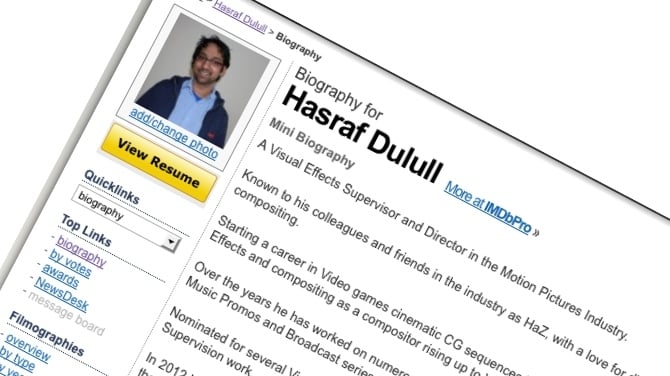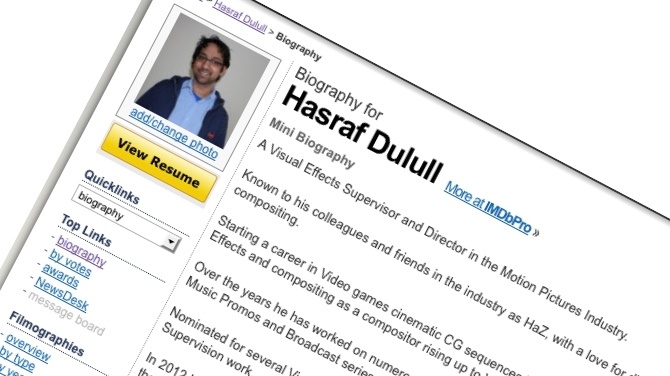
Replay: In Part 1 of this 3 part series about applying for Jobs in the VFX Industry, HaZ Dullul uses his experience as a VFX Supervisor and Producer to explain what he looks for in the in an application: what really works to get his attention - and what turns him off
 HaZ Biog.
HaZ Biog.
The Visual Effects industry workforce is mainly freelancers and contractors, which means there is always an influx of freelancers sending their updated CVs and Reels, studios looking to hire for the next big show, or a crisis of too many last minute shots in a major show.
The essentials for any job application in the VFX Industry (or the creative industry in general actually!) are the Show-reel and CV, so it’s obviously important to get those things right before approaching studios.
The Showreel
Keep it less than 3 minutes long: anything longer will just get boring. Most Supervisors, Leads or Producers who look at show-reels don’t have much time in their busy production schedules (the only time I get to view reels is on my lunch break or evenings!), so keep it short and concise and relevant: show of the skills that are required for the job.
Show your best work! It’s not about quantity but it is about quality. You will get a chance to show off other stuff (maybe your experimental work) during the interview should you wish. I remember being slightly put off with an artist reel because the last shot stuck in my mind after viewing the reel. It was a really bad shot with shoddy keying, yet there were a lot of other shots which were good; but that one bad apple killed it.
Don’t bother trying to edit it to music because the reel is showing off your visual effects. You can add a track for presentation purposes should you wish but it won’t be that factor that lands you an interview. I always turn the sound off anyway.
Everyone knows it’s hard to get your latest shot from a feature film or TV series that is not yet released. If you did get your shot the associated layers then you obviously managed to copy it on your drive from your workstation before leaving the studio. Keep it until the film is released then show it. Do not put material from projects not released yet in your show reel, because I for one would think you would do the same to my studio. I think this shows a lack of professional integrity. I have heard about studios black-listing certain artists who did exactly this so make sure you don’t fall in that trap. Do the right thing: use your common sense and don’t show that off in your reel yet. You're probably thinking: "how do you prove your latest work to secure your next gig?" If you say you worked on a major film project at a studio, then chances are the person interviewing you will call up the studio for a reference and that’s usually good enough to prove you worked on that project and what you did on it.
What I look for when reviewing show reels from artists
If you're a compositor then I would expect to see some breakdowns of your shot. If that’s not possible then clearly mark on the frame what you did on the shot.
I would also expect to see how well you integrate CG into live action, tracking, creating clean plates and good articulated mattes and rotoscopes.
If you are a CG Artist then I would expect to see wireframes of your models and different passes such as textures, shaders and lighting passes. (Ambient Occlusion passes always look good in reels). You may be a specialist such as a modeller, texturing artist, lighting and rendering etc. So make sure there are as many turntables and passes to show off as possible: the clearer you demonstrate what you created, the more chances of you landing that gig.
If you are an animator then I would love to see any rigs you created and of course animation passes of your work. But a clip of your animation in the film is good enough provided you clearly state what you animated. If you did animation clean-up then make sure you state that and perhaps show the original version before you did the clean-up and the version you cleaned up.
Do not show motion capture animation and say you animated that, because you will look silly when you are caught out or asked to animate something as good as that.
Vimeo
Here’s a tip: Set up a Vimeo account (it’s free) and you can show off your show reel in HD and stream fast too (to iPads, iPhones, laptops etc., without the need for QuickTime or Flash). You can also password-protect your reel too. The Vimeo environment presents your work nicely. I have a Vimeo-pro account (ie a paid subscription one) and allow me to use my own domain name and also break up my reel into shots like a catalogue of shots with breakdowns and description of the project.
Here is an example from my Vimeo reel portfolio site.
The CV and References
These days you don’t need to go through the tedium of formatting a CV in Microsoft Word and having to update it every time you apply for a new project. LinkedIn is the new CV! If you maintain your profile regularly you will end up having a more concise and updated CV, which has company and project details with references (former colleagues leaving you recommendations). You can save that out as a PDF and - viola - your CV is ready in a few seconds! Not only does it look lovely - and easy to read with its formatting, but you can also send the public profile LinkedIn link (for anyone to view your CV without logging into LinkedIn).
Here is an example of my public LinkedIn CV
I get reference requests from studios all over the world asking me to fill in a questionnaire about former colleagues who has applied to work at their studio. I am always honest and tend to reflect on what they did well and what shot they worked on, and I mention the highlights of the experience of working with them.
Be honest! Don’t embellish your CV by calling yourself a Lead when you weren’t. Don’t call yourself the Producer when you were Co-ordinating (a job just as important but requires different tasks and responsibilities).
The best thing to do is to just list the type of work tasks you did on the show as bullet points, and mention who your supervisor was. That’s it! It doesn’t need to be an essay or big paragraphs of explanation.
Also before you put down a reference it’s worth checking if that person still works there or you have their latest contact details (that’s where LinkedIn comes in handy to be updated with your connections regularly). Most importantly use references of someone you actually worked with (who supervised you for example) and not a colleague you are merely friends with, had lunch or sat next to.
If you work in feature film or TV series visual effects, then it’s essential to have an updated IMDB entry, as this is a good way to build up industry credentials, and most VFX facilities expect to see an IMDB listing when recruiting for feature film projects.
It also shows that you are serious about a career in the industry. Your IMDB link should also be on your CV and show reel site.
Keep it updated and always check with your line producer or supervisor what credit you are entitled to use (whether its in the film or on your freelance contract). Here’s my IMDB page as an example.
Tags: Business


Comments